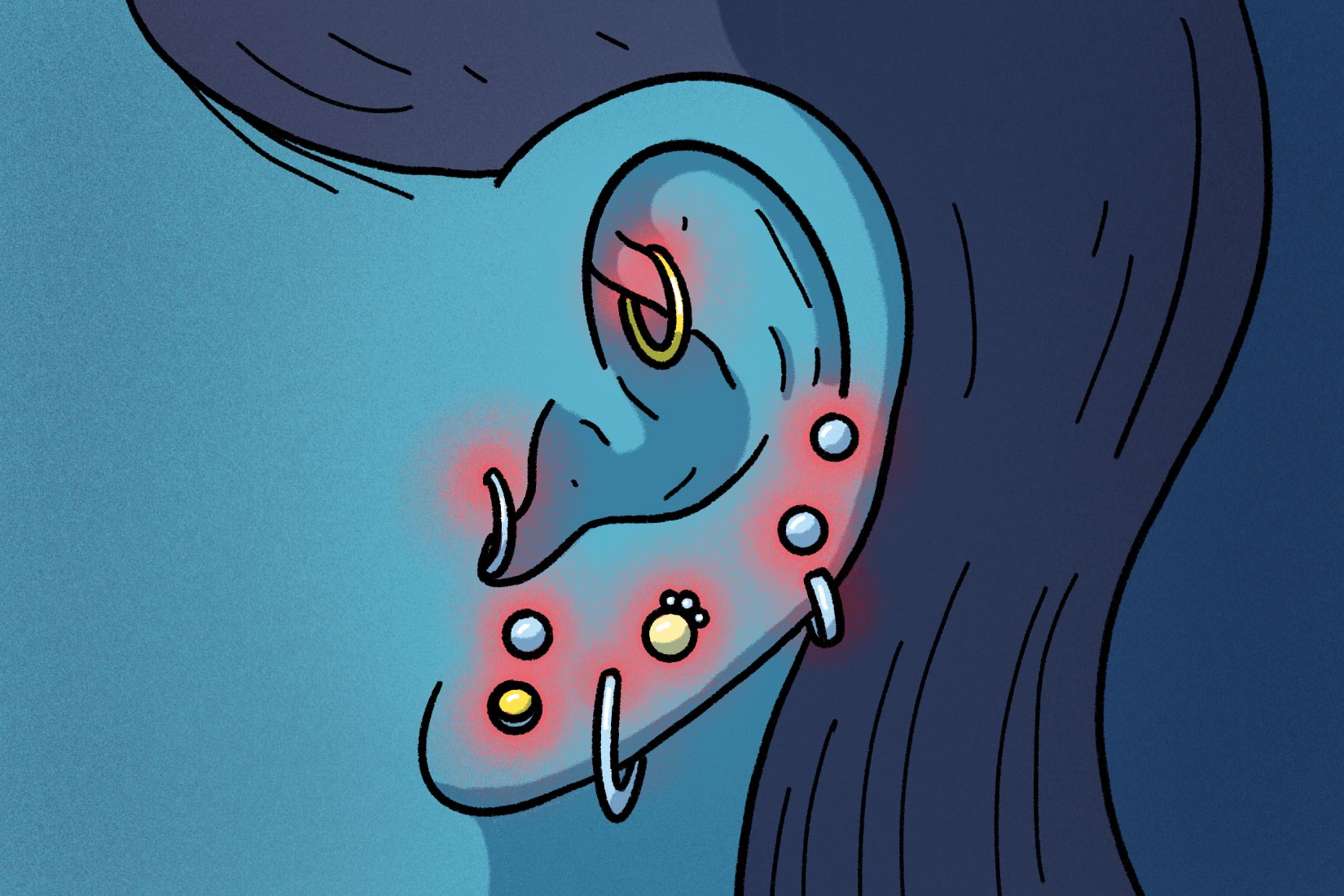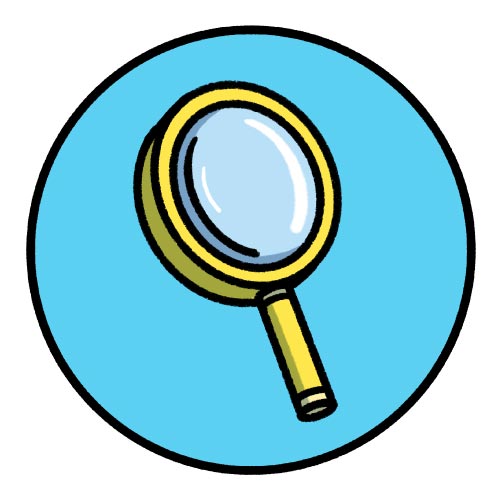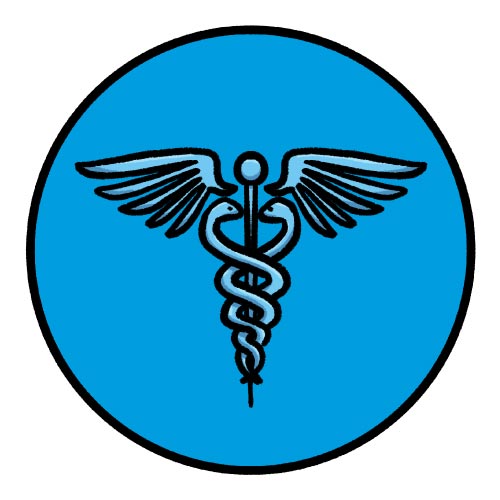
While all piercings carry some risk of infection, proper piercing safety and aftercare will give you the best chances at avoiding one. However, it is possible that even with proper aftercare, a new ear piercing can still become infected during the healing process. Some infections are minor and can be successfully treated at home, though some may require medical care. In this article we’ll cover these basics about ear piercing infection and care:
- How to Tell if Your Piercing is Infected
- How to Treat an Infected Ear Piercing at Home
- How to Tell if You Should Seek Medical Help for an Ear Piercing Infection
 How to Tell if Your Ear Piercing is Infected
How to Tell if Your Ear Piercing is Infected
It’s normal for the skin around a new piercing to look a little unusual for a while, so don’t panic if it does. Just because there’s something going on doesn’t mean it’s necessarily an infection. The information below will help you determine whether you’re experiencing ordinary healing symptoms, a piercing complication, or if your piercing really is infected.
Signs of Normal Healing
After a piercing, the body will take steps to begin healing as it would after any other type of wound or physical trauma. The typical healing time for an earlobe piercing is 6–8 weeks, while ear cartilage piercings typically heal in 6–12 months, depending on the specific person and piercing site. During that time, you can expect some light bleeding, swelling, itching, and the discharge of clear lymph fluid. Good ear piercing aftercare should help alleviate these normal healing symptoms.
Treating Normal Post-Piercing Swelling
If the swelling around your new piercing is uncomfortable, you can treat it with a non-steroidal anti-inflammatory (NSAID) like acetaminophen and by applying cold compresses. If you use cold compresses, make sure that you wrap them in a clean towel or paper towel and only apply them for about ten minutes at a time. Use a clean towel for every application. If these steps do not reduce the swelling, see your piercer immediately. They may need to replace your jewelry with a larger size to prevent tissue death and infection.
Signs of Hypergranulation
Hypergranulation is typically the result of excessive moisture and pressure on a new piercing. It presents as a reddish bump next to the piercing that may appear to be fluid-filled, or as a ring of puffy reddish skin around the piercing. If you are experiencing hypergranulation, you can ask your piercer to replace your jewelry with a more loose-fitting option and add one additional sea salt solution soak per day to your aftercare routine. Typically these steps bring hypergranulation under control within a week or two.
Signs of Allergic Reaction
If the area around your ear piercing begins to develop an itchy rash, immediately consult your piercer. It may be the case that you’re experiencing an allergic reaction to the material your jewelry is made of. Typically, allergic reactions are caused by low-quality jewelry with high nickel content.
Signs of Bacterial Infection
It is likely that your piercing has become infected if you experience any of the following symptoms during the healing process:
- Discharge of thick, yellowish pus from the piercing
- Red streaks on the skin around the piercing
- Skin around the piercing feels hot to the touch
- Excessive swelling, itching, or pain that does not subside
 How to Treat an Infected Ear Piercing at Home
How to Treat an Infected Ear Piercing at Home
If you’ve caught the infection early, it might be possible to treat it yourself at home. However, you should keep in mind that ear cartilage piercing infections are generally more difficult to self-treat than earlobe piercing infections. Do not remove your jewelry, even if your piercing becomes infected. Doing so could allow the piercing to close, trapping the infection inside your body.
At-Home Ear Piercing Infection Treatment Steps
- Always wash your hands with antimicrobial soap and warm water before handling or cleaning your piercing and jewelry.
- Clean the piercing site and jewelry with a full sea salt solution (SSS) soak three times per day or use a sterile piercing aftercare spray. Clean both the front and back of the piercing, as well as the jewelry itself, with a SSS-soaked cotton ball and then pat the area dry with a paper towel. It is not necessary to move or rotate your jewelry while cleaning.
- Rinse the piercing with an antiseptic piercing spray twice per day between full soaks and pat dry with a paper towel.
At-Home Ear Piercing Infection Treatment Tips
- Do not apply any type of alcohol or hydrogen peroxide to the piercing. These can dry out and irritate the skin, destroy helpful cells, and further damage skin tissue, prolonging the healing and disinfection process.
- Do not apply cosmetics, ointments, creams, or balms to the piercing. These can trap bacteria in the piercing.
- Take the following steps to minimize environmental risk factors that might expose your piercing to additional trauma or bacteria:
- Clean your cell phone with disinfecting wipes each day
- Tie back long hair to avoid snagging it on your jewelry or putting your piercing in contact with any hair care products
- Change pillowcases and sheets
- Avoid pools, hot tubs, or otherwise fully immersing your piercing in water
Within 48 hours of beginning these at-home treatment measures, you should see an improvement in the symptoms of infection. Continue these steps until the infection symptoms have completely subsided.
 How to Tell if You Should Seek Medical Help for an Infected Ear Piercing
How to Tell if You Should Seek Medical Help for an Infected Ear Piercing
Although many ear piercing infections can be successfully treated at home using the steps outlined above, you should contact your primary care doctor or an urgent care center immediately if any of the following occurs:
- The symptoms of infection are the same or worse after 48 hours of at-home treatment
- The symptoms of infection spread beyond the piercing site
- The area becomes so swollen that the jewelry cannot move or becomes embedded in your skin
- You develop a fever in addition to the previous symptoms of infection
In these cases, it is likely that a doctor will need to prescribe you oral antibiotics to successfully treat the infection. Continue your full piercing aftercare routine in addition to taking antibiotics to treat the infection.

